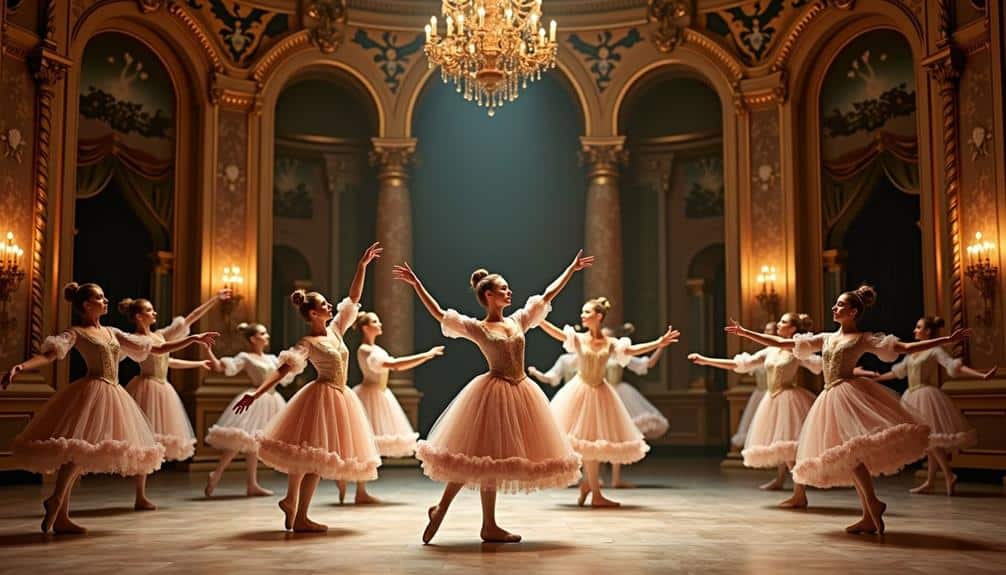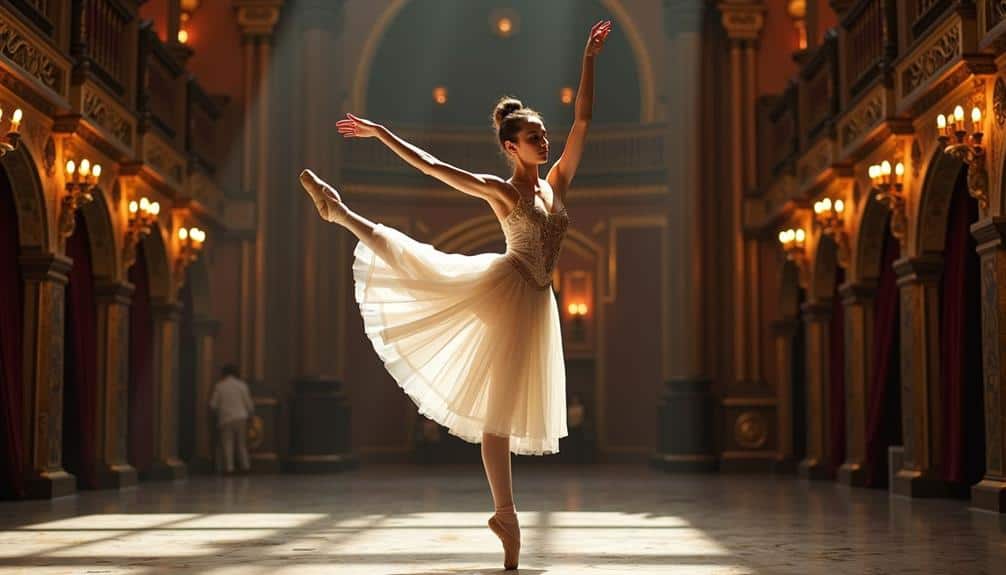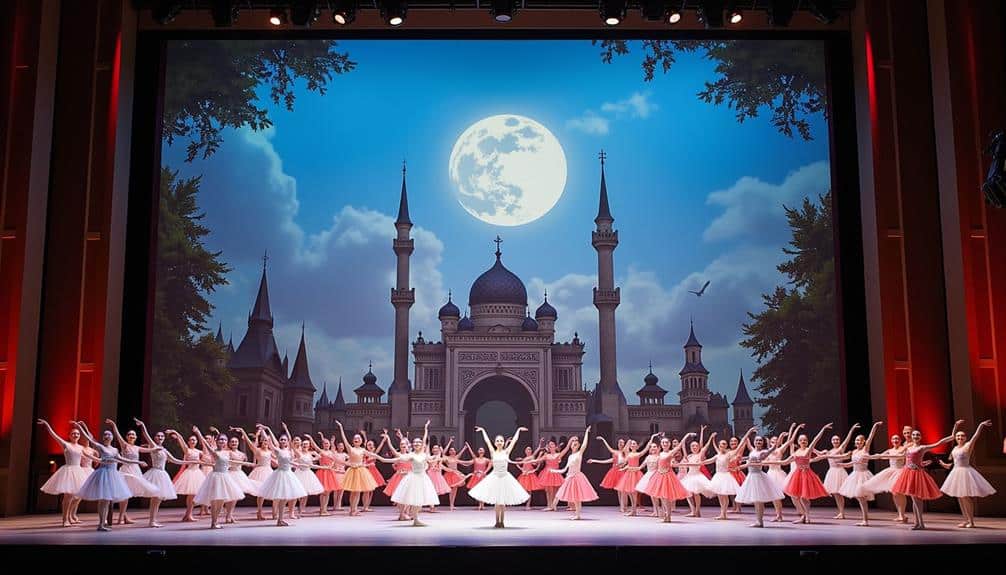When you think of ballet, Russian influence is undeniable, shaping its very essence through pioneers like Marius Petipa and Michel Fokine. Their contributions laid the groundwork for masterpieces such as “Swan Lake” and “The Nutcracker,” which have captivated audiences worldwide. Russian ballet’s technical precision and emotional depth have set high standards, transforming training programs globally. But how did this art form, once centered in imperial Russia, become a worldwide phenomenon? And what does the future hold for its continued evolution in modern performance?
Origins of Russian Ballet

The origins of Russian ballet are deeply rooted in a rich tapestry of cultural exchange and imperial ambition.
You’ll find that Imperial patronage played a significant role in its development. The Russian tsars, eager to showcase their sophistication, invested heavily in ballet, attracting European talent and fostering artistic exchanges. This led to the establishment of ballet schools that became the foundation of Russian ballet’s evolution timeline.
In the early performances, you can see the blending of Russian folk influences with classical European dance styles. These early adaptations were crucial in shaping a unique national identity within the ballet world.
Russian ballet began to distinguish itself not just through technical prowess but also through emotional depth and storytelling.
As these artistic exchanges continued, Russian ballet schools refined their techniques, elevating the quality of dance styles practiced and taught. The emphasis on rigorous training and the incorporation of folk influences created a distinctive, expressive form of ballet.
This evolution timeline reveals how Russian ballet transformed from a royal pastime into a national treasure, embodying the cultural and artistic aspirations of the Russian people.
Key Figures and Choreographers
Several pioneering individuals have left an indelible mark on the landscape of Russian ballet, shaping it into the globally revered art form it’s today. When you explore the Ballet Evolution, understanding the contributions of seminal figures like Marius Petipa, Michel Fokine, and George Balanchine is essential.
Petipa, often considered the father of classical ballet, refined choreographic styles with his intricate and emotive storytelling. His works, such as “The Sleeping Beauty” and “Swan Lake,” are foundational to the ballet repertoire.
Michel Fokine, a revolutionary force, introduced modern choreography that broke away from Petipa’s classical constraints. His dynamic and expressive approach in ballets like “The Firebird” and “Petrushka” brought a new emotional depth and narrative complexity to the art form.
Fokine’s principles of unity and expressive movement significantly influenced Ballet Evolution.
George Balanchine, co-founder of the New York City Ballet, further transformed Russian ballet by blending classical techniques with contemporary dynamics. His abstract choreographic styles, exemplified in “Serenade” and “Apollo,” emphasize musicality and athleticism, pushing the boundaries of traditional ballet.
Through these individuals, Russian ballet has continually evolved, impacting the global performing arts landscape profoundly.
Iconic Ballet Productions

Immerse yourself in the world of iconic ballet productions, where masterpieces like “Swan Lake,” “The Nutcracker,” and “Giselle” have captivated audiences for generations.
These legendary performances aren’t just spectacles; they’re choreographic masterpieces that reflect the profound artistry and technical prowess inherent in Russian ballet.
“Swan Lake,” composed by Tchaikovsky and choreographed by Marius Petipa and Lev Ivanov, epitomizes the dramatic storytelling and intricate choreography that define Russian ballet.
The dual role of Odette/Odile challenges dancers to convey both purity and deceit, showcasing their versatility and emotional depth.
“The Nutcracker,” also by Tchaikovsky, has become a holiday staple worldwide.
Its enchanting score and imaginative choreography transport you to a magical world, making it a beloved tradition.
Each character’s dance, from the Sugar Plum Fairy to the Russian Trepak, highlights the diverse range of classical ballet techniques.
“Giselle,” with its hauntingly beautiful narrative and choreography by Jean Coralli and Jules Perrot, tests a dancer’s ability to portray both innocence and supernatural grace.
The ballet’s second act, known for its ethereal wilis, exemplifies the ethereal quality and emotional intensity that Russian ballet brings to life.
Influence on Western Ballet
Bridging the gap between Russian and Western ballet traditions has profoundly shaped the evolution of performing arts. When Russian ballet companies first toured the West, they brought with them a unique blend of technical prowess and expressive Russian aesthetics. This cultural exchange sparked a Western reinterpretation of ballet, leading to a stylistic evolution that melded the best of both worlds.
You can see how ballet collaborations between Russian and Western choreographers and dancers resulted in an artistic cross-pollination that enriched performance traditions globally. For instance, when Sergei Diaghilev’s Ballets Russes performed in Paris, it captivated audiences and inspired a wave of creativity that permeated Western ballet. This fusion of Russian grandeur and Western innovation created a new, dynamic form of ballet that emphasized both technical excellence and dramatic expression.
Furthermore, these global influences spurred an ongoing dialogue between Russian and Western ballet, continuously reshaping and redefining the art form. The impact of this cultural synergy is evident in the works of legendary choreographers like George Balanchine, whose training in Russia and subsequent career in the West exemplify this seamless blending of traditions.
Through these interactions, the world of ballet has become a richer, more diverse art form.
Russian Ballet Techniques

Russian ballet techniques have long been celebrated for their rigorous discipline and distinctive stylistic nuances. When you delve into these techniques, you’ll quickly recognize the emphasis on classical athleticism. Dancers undergo intense training to achieve remarkable strength, flexibility, and precision. This physical prowess isn’t an end in itself but a means to create intricate movements with seemingly effortless grace.
Moreover, Russian ballet is renowned for its expressive storytelling. Techniques are meticulously designed to convey deep emotions and complex narratives through movement. Each gesture, turn, and leap is imbued with meaning, allowing dancers to communicate profound stories without uttering a single word.
Incorporating elements from both the French and Italian schools, Russian ballet melds technical rigor with dramatic flair. The Vaganova method, developed by Agrippina Vaganova, exemplifies this blend. It focuses on the flow of movement, ensuring that transitions are smooth and harmonious. This method also emphasizes the importance of the upper body, creating a lyrical quality that enhances the storytelling aspect.
Understanding these techniques provides you with a deeper appreciation of the art form. The synthesis of classical athleticism and expressive storytelling makes Russian ballet a powerful and enduring influence in the world of performing arts.
Global Ballet Schools
Building on the profound impact of Russian ballet techniques, it’s fascinating to explore how these principles have been adopted and adapted by ballet schools around the globe. Prestigious institutions such as the Royal Ballet School in London and the American Ballet Theatre School have integrated Russian methods into their curricula, enhancing global training standards.
These schools emphasize rigorous discipline, precise technique, and expressive performance, hallmarks of the Russian style.
You’ll find that global training now often includes Vaganova and other Russian techniques, which are renowned for their focus on strength, flexibility, and artistic expression. This integration has raised the bar for ballet competitions worldwide, where dancers trained in these methods frequently excel.
International competitions like the Prix de Lausanne and the Youth America Grand Prix serve as platforms showcasing the high level of proficiency achieved through such training.
Moreover, the exchange of teaching methods between Russian and global ballet schools has created a rich, diverse educational environment. This cross-pollination ensures that students receive a well-rounded education, preparing them to excel on the world stage.
As a result, the legacy of Russian ballet continues to shape and elevate the art form globally.
Cultural Integration and Fusion

The cultural integration and fusion of ballet have led to a rich tapestry of styles and interpretations that transcend national borders. When you look at the history of Russian ballet, you’ll see how it has continually engaged in cultural exchange, absorbing elements from diverse traditions.
For instance, when Russian ballet companies toured Europe and the Americas, they didn’t just showcase their own techniques; they also integrated local styles and narratives. This artistic collaboration has resulted in a more globalized ballet form, bringing together various cultural aesthetics.
Analyzing this phenomenon, it’s clear that the mutual influence goes both ways. Western choreographers and dancers have long been inspired by Russian virtuosity and discipline, adapting these qualities into their own practices.
Conversely, Russian ballet has embraced aspects of Western modernism and contemporary dance, creating a dynamic fusion that keeps evolving. This blend has enriched the global performing arts scene, fostering greater understanding and appreciation among diverse audiences.
In essence, the cultural exchange facilitated through ballet has broken down barriers and built bridges, crafting a universal language of movement.
This ongoing artistic collaboration continues to shape the future of ballet, ensuring its relevance and vitality in an ever-connected world.
Modern Adaptations and Innovations
Embracing modern adaptations and innovations in ballet has revolutionized how we perceive and engage with this classic art form. Contemporary choreography has breathed new life into traditional Russian ballet, blending elements of modern dance and experimental movements while retaining the core principles of technique and grace.
You’ll notice how choreographers like Alexei Ratmansky and Yuri Possokhov have masterfully integrated narrative and abstraction, pushing boundaries and expanding the audience’s emotional and intellectual experience.
Digital performances have also transformed the way you can access and appreciate ballet. With the advent of high-definition streaming services and virtual reality, geographical and economic barriers have diminished.
Now, performances from the Bolshoi Theatre or the Mariinsky Ballet can be experienced in your living room, providing an immersive and intimate connection to the art. This digital shift hasn’t only broadened the reach of Russian ballet but has also allowed for innovative stage designs and interactive elements that were previously unimaginable.




